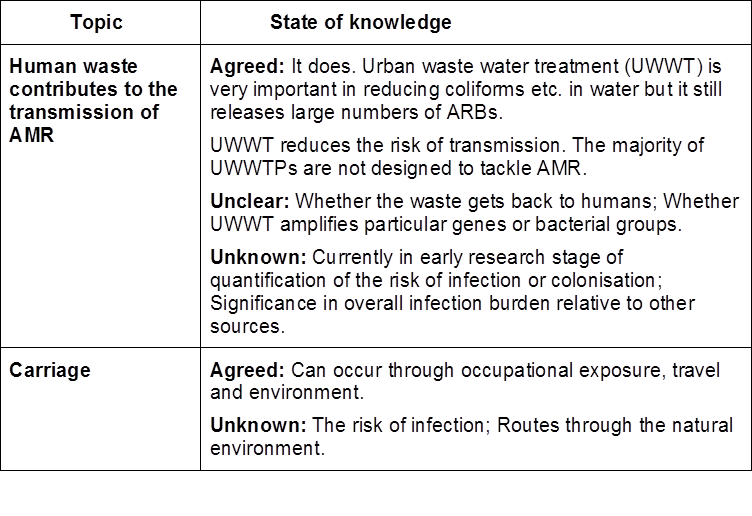Table of contents
5) Conclusions and further research needs
While there have been research projects and national initiatives into AMR and the environment, there is as yet nothing available at European level to assess the risks presented. The meeting agreed on several points regarding needs around monitoring and options for reducing the risks of transmission from discharges from urban waste water treatment plants and identified a number of gaps in knowledge which should be addressed (Tables 1-4).
In summary, there is a need to establish the role that UWWT has in limiting environmental and human health risks, focusing on antibiotics, antibiotic resistant genes and co-contaminants such as metals (co-selective agents). Risk-based targets are needed, which recognise resistance poses a human health risk as well as providing an ecosystem service. Surveillance data are needed to support management options. Methods of assessing relative risk presented by UWWT in terms of selection for resistance, transmission and exposure are required.
Table 1: Monitoring

-
What should be monitored; Unclear: spatial consumption: is it worldwide consumption? North vs South consumption in Europe?
-
I think it is important to note to screen especially also non-official bathing waters ... so waters which might be frequented by bathers, tourism, or hoppy fishers ...
Table 2: Release of treated urban waste water and transmission of AMR

-
"The [vast] majority of UWWTPs are not designed to tackle AMR"
In fact non of them are design for AMR but if you have desinfection you may tackle it, even if AMR was not the initial objective.
Table 3: Options / measures for reducing potential for AMR transmission via UWWT.


-
Industrial production: Agreed:
I would say "not mixing effluent into municipal waste water" makes more sense that the orignial sentence.
"Don't allow production sites to discharge to UMMTPs[, especally at development stage for new antibiotics]: alternatively, set discharge standards to UWWTPs"Hospital as hotspots: Agreed: collect and incinerate human waste for patients treated with new molecules.
-
Hospitals as hotspots:
Agreed: Known releases of antibiotics only used in hospitals, e.g. carbapenems.
Agreed: Possible collection and separate treatment, or even incineration, of human waste (urine and faeces) for patients receiving treatment with new antimicrobial agents. [THIS IS A REFORMULATION OF BERTRAND's STATEMENT].
Unclear: Could undertake regulation on release of antimicrobials and other medicinal products by hospitals and other healthcare facilities.
Table 4: Knowledge gaps

-
UWWT: I guess it is in relation to pollutants such as heavy metals or chemicals (co-selection)

-
regarding the editing note, my understanding is that production sites releasing untreated effluents into sewers and UWWTPs create an increased risk at these specific locations
-
MAnufacture of antibiotics: Questions regarding higher consideration of effluent management for the productions of new molecules, even at the development stage.



Add "cost/benefit analysis on potential additional measures for UWWT (collection and treatment) are required to justifyinvestment and political decisions